Depths of the Dempster
“Into each life, a little rain must fall” – – unknown
I know where it started. It was just at the end of our visit to Tombstone Park, as the smoke started to come in. There were some typical lightning-started forest fires to the west, and we were getting the wind-drifted smoke.
I’ve had a LOT of experience with smoke plumes. In the western States, they’re quite common, and in my flying years I had to carefully preview, forecast, and negotiate the reduced visibility many times. So we knew that we would have to drive many miles to get past the smoke, and back to “scenic” traveling. What we did not know was that we would not see normal daylight in the next 400 miles.
So this post is going to be a little different from the ones preceding. I don’t have a dozen gorgeous scenic photos to share, because we just couldn’t take any. What I do have is an account of the northern 400 miles of this remarkable highway, and some commentary on its pros and cons. I’ll also journal some of our “adventures” with mud and dirt, mosquitoes, mis-haps, and breakdowns.
Heading north out of the Tombstone Park area, this is a representative smoke-dulled landscape. No blue sky or white puffy clouds, just a seamless dull haze, reminiscent of big-city smog. We were also regularly reminded that the Dempster is a “haul” road, put in place for transportation of goods and materials – only secondarily useful for us tourists.
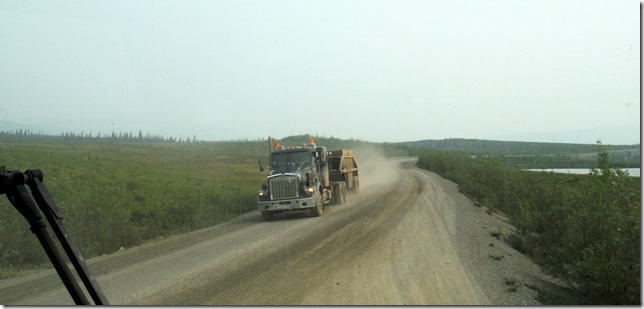
We tourists are convenient, and tolerated, because we bring money. But we share the road with the big heavies: semis and maintenance vehicles. These guys come in three sizes: courteous (rare), oblivious (normal), and belligerent (scary). The courteous guys (mostly construction) are not in a hurry and will slow down and move over to help you get by. The oblivious guys (truckers) will simply ignore your presence and zoom on by without slowing, pulling over, or any acknowledgement. The belligerent ones will blast by you in either direction at 30% over the speed limit, using the best possible track in the road regardless if it makes you pull over and risk running off the shoulder. (Fellow campers are almost 100% in the courteous category.)
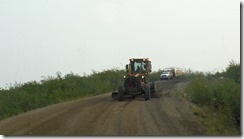
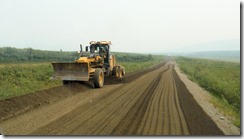
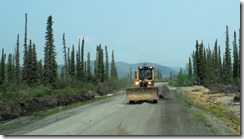
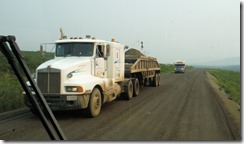
One of the most-dangerous elements of the road is when it is extremely dusty (about 20% of our trip) and a big truck howls past from the opposite direction. The trailing dust cloud makes the road invisible for about 200 yards after the passage. You just have to slow down, steer straight and wait for things to appear again. Scary. Some trucks have these enormous grill-guards. I assume they are to protect the truck from moose and tourist impacts.
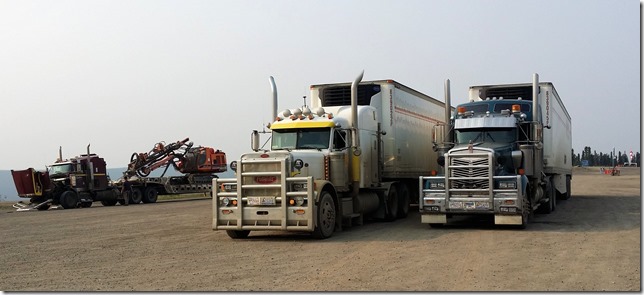
In our previous travels through B.C and Yukon, construction work was almost always coordinated via flag-persons to control traffic. (Sometimes there wasn’t much warning, and we’d come around a 90kph turn to find a flagman standing in the middle of our lane.) Here on the Dempster, it’s more like a game of “chicken” to see who gives in first. With us, we always let the 25-ton road-grader win.
Along with all the obvious maintenance (grading, blading, etc.), there is some relatively hidden stuff that goes on. It’s absolutely critical that the roadway NOT allow the underlying permafrost to melt. To monitor the integrity of the permafrost, crews periodically measure its qualities using ground-penetrating radar and electrical resistivity techniques. Here is a guy (that’s a mosquito net on his helmet) getting ready for a 30-mile run dragging sensors up the highway. Parameters are recorded, and then he makes a 30-mile run back down the same road in the opposite lane. This is done periodically for the entire 457 miles of the Dempster.
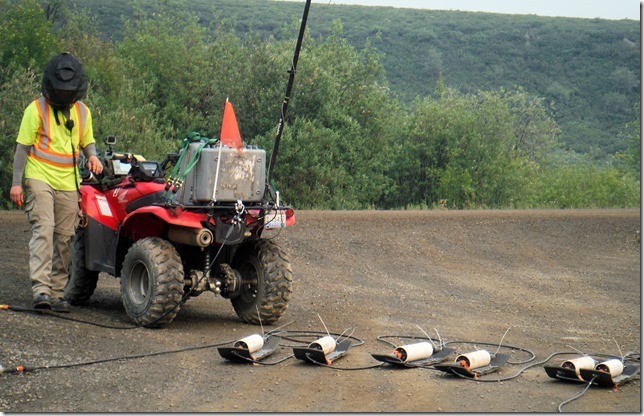
Every once in a while, we get a small treat from the endless blank stare of the smoke-covered terrain. These Dall sheep were close enough (about 400 yards) so that the smoke didn’t mar the shot. These sure-footed miracles stroll around and take a nap on terrain that you and I would hardly be able to stand on. When they really concentrate, they can run up and down near-vertical escarpments.
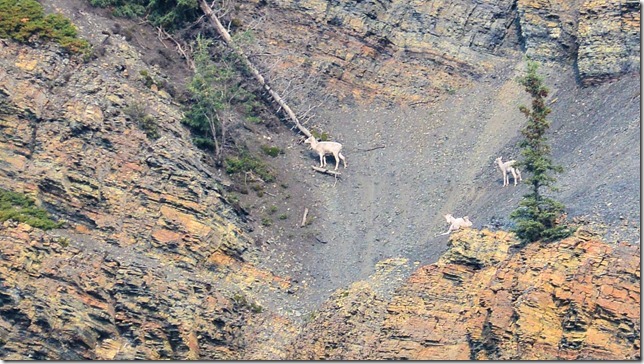
Next stop after Tombstone was Eagle Plains. This is a true Outpost in every respect. Maybe 50-100 people live to support a tire and gas stop, motel, restaurant, and RV “park”. The picture will show you that the Park is a parking lot. Except for a few powered sites five feet apart, it’s kind of random, first-come first-served. If it runs out of room, you can park across from the gas pumps, or out back above the drain water reclamation pond. Dirt, dust, gravel, ruts, a few picnic tables – – – oh, and really decent wifi in the motel for CA$5. (This alone is worth the stop.)
It’s funny, we would run screaming from a place like this in the States, but up here at the end of the world, there’s a kind of travelers’ camaraderie that exceeds even the friendly experiences we’ve had elsewhere. People are largely soft-voiced, easy-going, and don’t run generators. Don’t get me wrong, it’s not scenic or esthetically pleasant – – but they had gas and wifi and a flat spot, after 230 miles of dirt road. We were glad to be there.
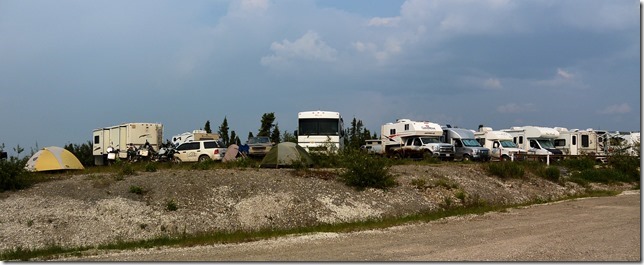
At this point, Ralph had traveled 230 miles behind/in Howie’s dust cloud. We thought he was looking pretty cruddy – – little did we know what was to come.
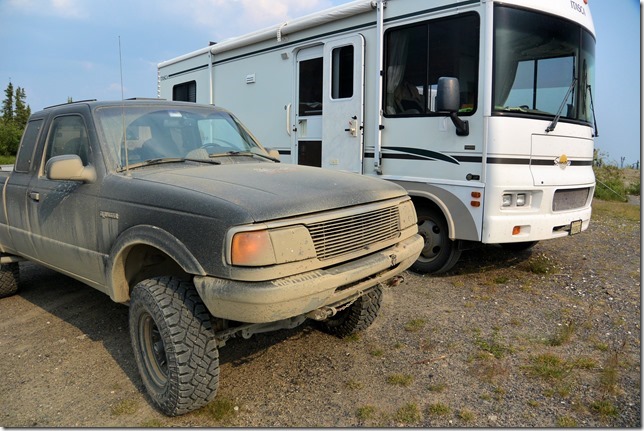
One of the intrinsic travails of travel is simply the risk entailed by sitting in a moving vehicle. While we were camped at Eagle Plains, we talked to a woman who had poorly negotiating the road-edge in a gentle turn, and flipped her truck/camper upside down. She was quite put out with herself, having first let the vehicle get too far to the right, and then over-correcting twice before the sad end of that day’s drive. Nobody was hurt, amazingly enough, especially when you see the wreckage.
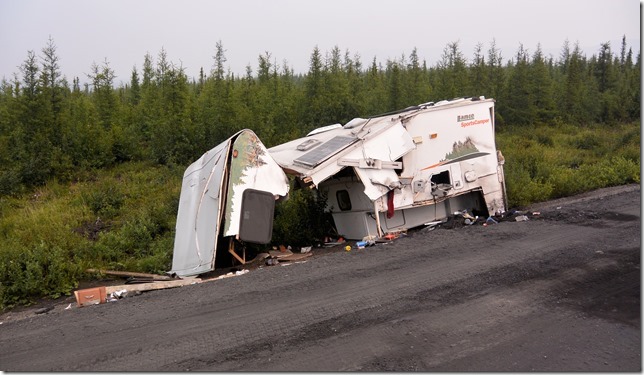
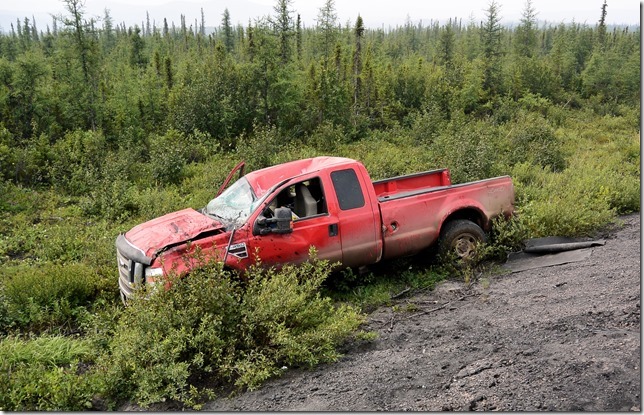
This was a pretty sobering sight, especially later on as the road worsened in various sections. A couple of times, Howie got a little squirrely, and I quickly recalled what happens when you let the road start to control things.
For us, a much-anticipated highlight of this leg of our trip was passing the Arctic Circle. All this fuss is simply the place on the Earth where the sun disappears completely for a full day in the winter, or never sets at all for a full day during the summer. It’s all due to the way the Earth is tilted on its axis. In actuality, various influences of atmosphere and terrain blur the entire distinction. You can experience wide variations in sunrise and sunset well north and south of the Arctic Circle. But hey, it’s still pretty cool.
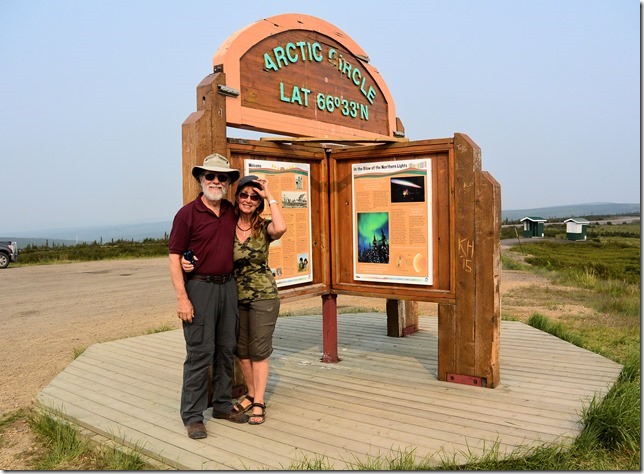
North of the Circle, the mountainous countryside starts to roll off. Any detail is lost in the smoke, but you can still see the hills sloping down to the tundra and wetlands that end up at the Mackenzie River delta and Inuvik. The trip through these mountains and down into the plains is full of splended scenes at almost every hill and turn — it should be one of the delightful treats of the journey. We are hoping for better views on our return leg.
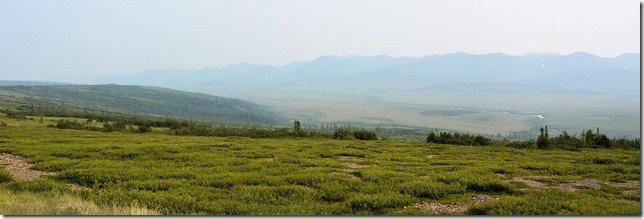
With 180 miles to go, the road quickly disappears into the smoky valleys. We keep thinking about all the grand views we are missing – this is some of the wildest, biggest country we’ve ever <almost> seen.
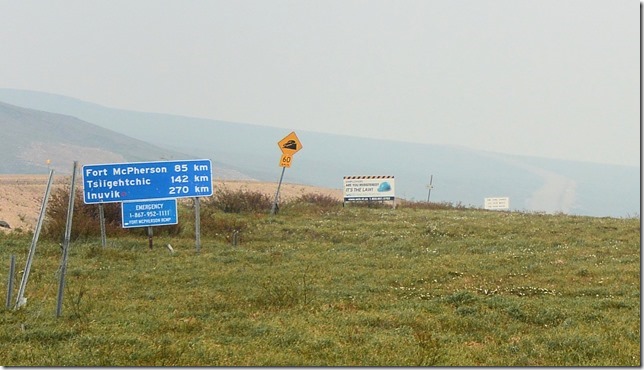
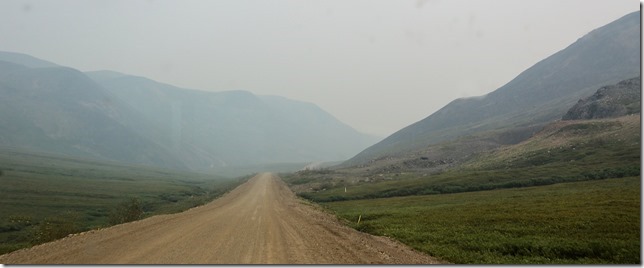
South of Fort McPherson, a small ferry takes us across the Peel River. These boats and crossings are pretty interesting – they simply blade up a sharp river bank on each side, and the ferry drops a huge metal plate down on the top edge of the bank. When things get chewed up by traffic, they just bring in the cat and bulldoze it clean again. I’ll guess that the seasons change the river bank such that any permanent fixture just doesn’t make sense.
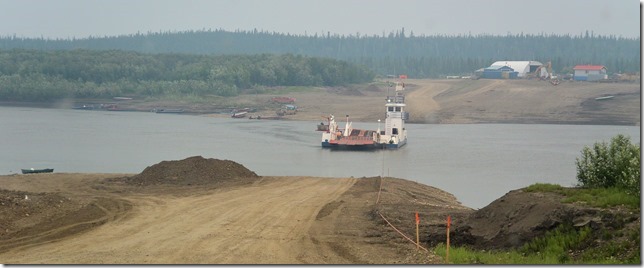
Much beefier ferry boat at the Mackenzie River. Quite a bit heavier current to deal with as well.
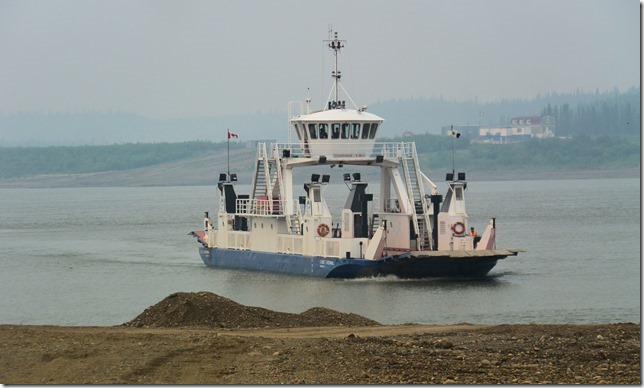
Howie’s GPS showing us in the middle of the Mackenzie. Six mph yet, quite a swimmer.
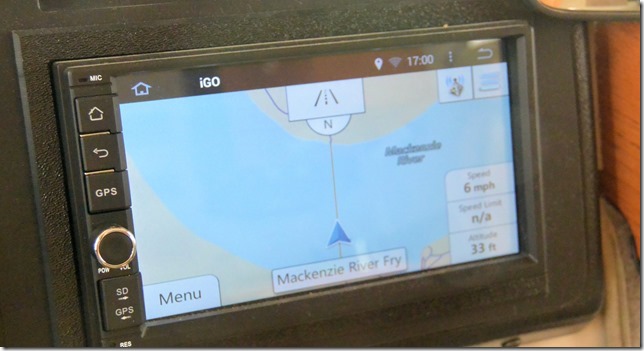
Around Fort McPherson, the road started to get really “interesting”. Maintenance trucks were scattering calcium chloride (CaCl), used as a binding agent, and then wetting it down (to mix it and to lay the dust). They had sprayed prodigious amounts of water on the roadway, making it look like a hard rain had been falling for hours. It was a little slick, but I managed to keep Howie and Ralph pointed straight most of the time.
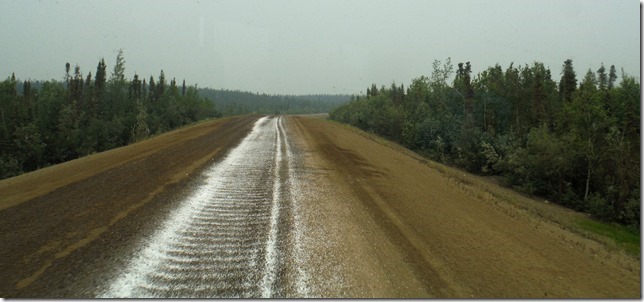
A couple of additional comments on the Dempster road quality. It’s not all bad and it’s not all good by any means. There are huge stretches of near-asphalt quality road, where I was doing 60+ with ease. But there are also some sections with washboard or just plain rough, rocky surfacing. There are rutted sections ass well, which tend to try to take over the steering – not good. The overall ride quality averages out at somewhere just below ROUGH, with the result that things in Howie are starting to come loose. Nothing serious, but that will require attention when we get near a hardware supply. Fatigue factor is probably almost 2X normal driving, because I have to watch so carefully, and constantly make position adjustments to avoid the worst parts of the road.
When we stopped to camp (about 20 miles south of Inuvik), we took stock of the impact of all that slimy travel. Impressive. Ralph is totally blind. A very cheap paint job.
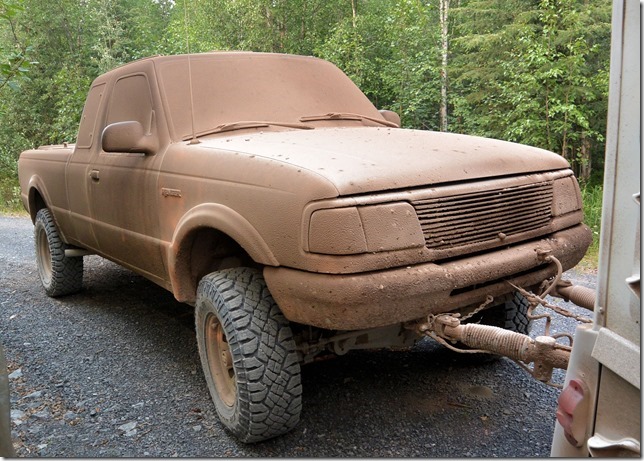
This camp (Caribou Creek) introduced us to some serious mosquito predation. One step out the door and they were pouncing on us like hail in a thunderstorm. We could scarcely breathe without inhaling one or more of the little demons. They loved my hat – – –
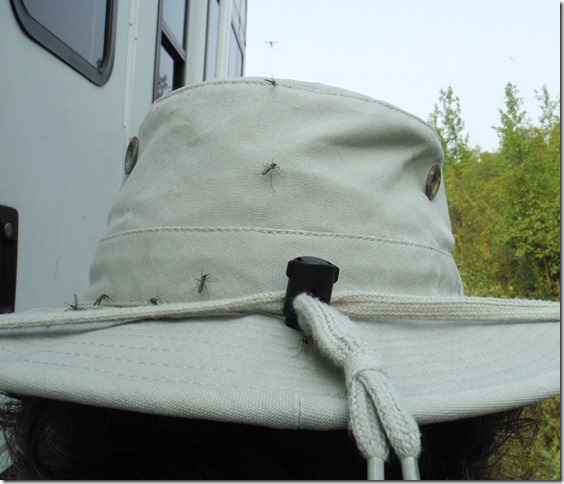
We had to resort to desperate (non-fashionable) measures. But even the mosquito-shirts were not sufficient; if we let them touch our skin, the damn bugs would bite us right through the jackets. We surrendered and hid inside Howie. We were safe there – – – or so we thought.
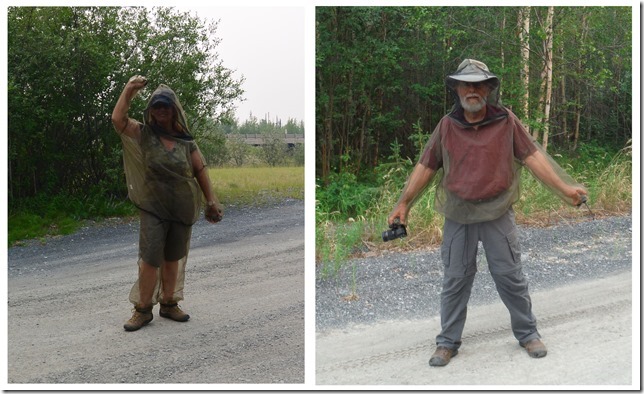
You know that whine. It starts faintly, then builds as it homes in on your ear. ZzzzzzznznznznznznznznnnNNNN tk! and the little flying drilling machine lands on your ear lobe. A very gentle little tickle, but you KNOW what’s coming — a tiny sharp stab and a two-day-long red itchy welt. This took place maybe 20 times for each of us. I swatted the sides of head so many times, my ears were ringing. There was just no relief to be had. So we got out of bed, chased them around with towels and flyswatters, killed them all and went back to bed. For about ten minutes. Then a second squadron came on duty. Repeat. Much groaning and hysterical laughter.
Long story short: for an hour, we battled the blood-sucking attacks, and they just kept on coming. Clearly, we had a “mosquito leak” somewhere. We found a lot of them coming through some small holes in the bathroom vent, so we shut it – – but there were hundreds still trapped under the lid.
Finally, in desperation, we got out a large sheet of mosquito netting and draped it over our heads. We kind of fiddled with it and kept it from touching our skin, and – after almost two hours of misery – drifted off to sleep. Here I am, desperately trying to preserve my blood supply. Recognize me?
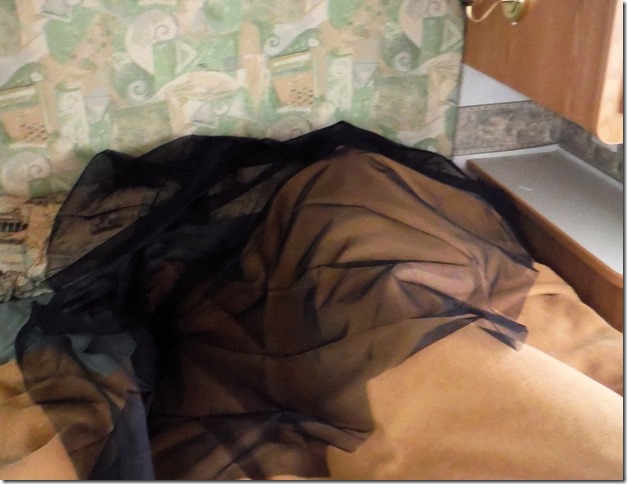
In the morning, bleary-eyed and grouchy, we grimly searched around Howie and found all the “mosquito leaks” and plugged them up. Wow, what a night.
We drove the short distance into town and got some gas (US$5.50/gal!). There was a vehicle-wash setup at the gas station, and we gladly paid for its use (self-wash).
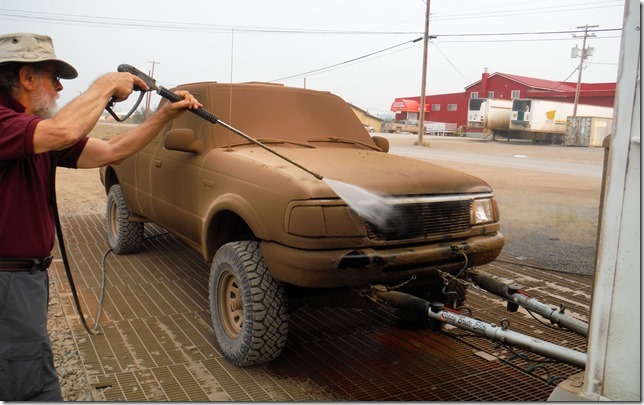
Karin suggested we rinse down Ralph’s engine compartment – a thought for which Ralph and I will be forever grateful. Things were so encrusted in road mud that I could hardly make the hood latch work. When I did get it open, look what I found. Even the radiator was completely coated and plugged up.
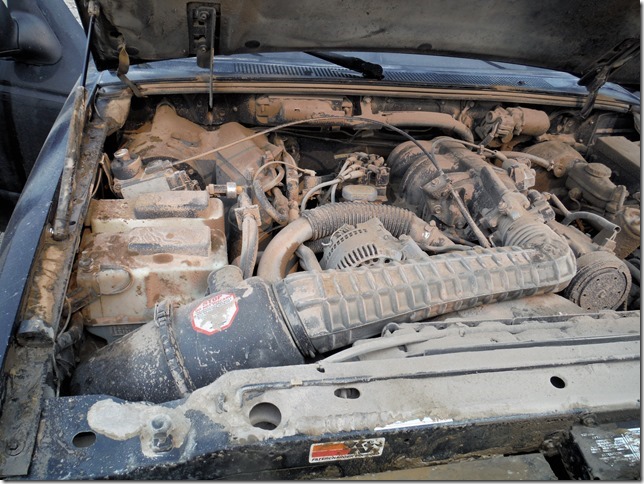
Well, it took I don’t know how many gallons of high-pressure water, but we got Ralph serviceable again. Uh, except for the alternator. Right after we started himi up, I noticed a low voltage reading, and sure enough it wasn’t charging the battery. He would run for a little while, but soon the battery would discharge enough that it would not run the engine’s electronics or fuel system. We could go back to Howie and charge Ralph’s battery with jumper cables – but we really needed a fix.
Now, finding a spare alternator in the town at the end of the world might seem a daunting task. And in fact, I was very much daunted, more so than I can remember in my much-daunted life. I figured I’d have to order one, have it flown in, wait several days, and take out a mortgage on my house to pay for it. But I might as well ask, right? An old sales friend of mine once said “If you don’t ask, the answer is always ‘no’”.
Unbelievably, the second place (of two) in town actually had an exact replacement in stock. I think I used up three years’ worth of good luck in that find.
Just an hour or so of mosquito-plagued wrenching and the new alternator was humming and volting away just like a good alternator should. What a fabulous recovery.
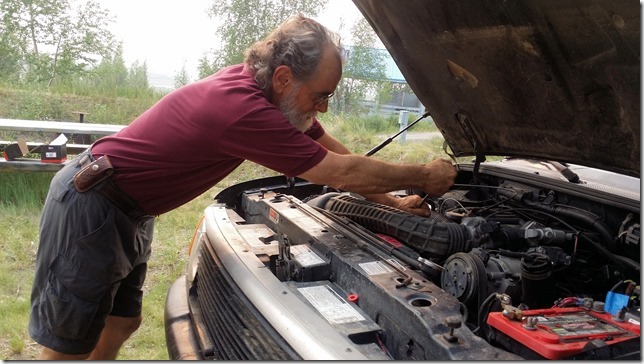
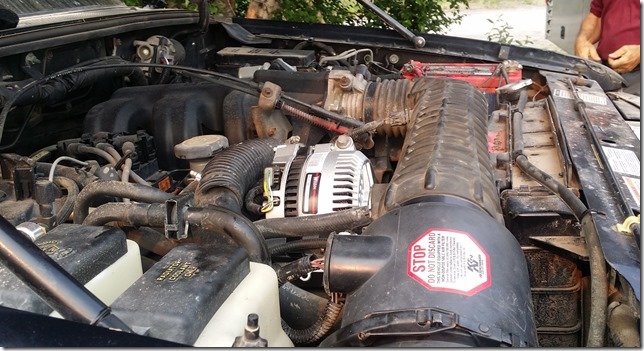
Simple breakdowns like this one may seem innocuous, but they bring into focus the stark reality of life in remote locales. We all rely so innocently on our complex vehicles and their comfort, shelter, and speed. It’s far too easy to lose sight of how easily they can fail, and how desperately disabled we are without them. Once again, we learn to never put ourselves in any position where our welfare or safety depend solely on a vehicle. You have to know how to survive when (not if) it breaks down. Backup plans (spare parts, survival kits, satellite phones, etc.) can be life-savers.
So here we are in Inuvik, 200 miles above the Arctic Circle and 60 miles from the Beaufort Sea (Arctic Ocean). Interesting town, to say the least. Maybe not in the way you’d think. But more about that in my next post.
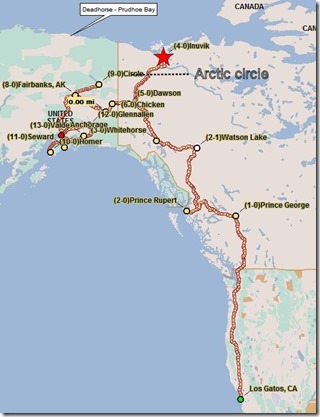 Miles driven (Howie): 4,200
Miles driven (Howie): 4,200- Miles driven (Ralph): 1,085
- Days traveling: 44
- Miles from home: 3,153

Fantastic post Greg.
You and Karin are such brave souls. I am a wimp, no question about it.
Mike
Hmmm, is there a clear distinction between brave and foolish? We may be flirting with its boundaries.
It’s late July now, and stuff is still breaking. It’s not clear if it’s coincidence, or being rattled too severely.
:o)
Thank you for such a great write-up, One of the best write-ups I’ve ever read. You made us feel like we were in the backseat with you and yur wife.
Salud my friend and safe travels.
My sincere compliments on your writing and willingness to share the good and ok not so good.
WOW what a road trip /Greg I love the way you write and Karin it looks like you your a great co pilot all and all you guys are my heros , keep having fun xo M
Nice picture of you and Karen at the 66/33 crossing..no mosquito nets YET !!! so now you re in Inuvik..supposed to be the largest caribou herds around..
glad you found an alternator…you’r pretty lucky there..
The mosquito’s are really a pest..I remember it very well..the DEE spray is very helpfull..if you can find it ..
Very interesting about driving behavior of the big riggs..I guess they are the king of the road..
Thanks again Greg and Karen for the interesting pics and story..
keep them coming..tony and marlene..take care ..
This is so cool! Is it cold up there?
Is it cold? Depends on what you mean by cold.
For sure, we were in a “heat spell” (for up here) where the temps were 86-87F for several days. Humid, too.
The next day, some rainy weather came in and the temps dropped to 48-49F. Quite a change, but not really “cold”.
We’ve been told that it has snowed at one time or another in all the summer months — Jun – Jul – Aug – Sep.
Wow! All I can say is Wow! Well at least you don’t have it as bad as Lewis & Clark did, but then they didn’t have to worry about oncomming crazy truck drivers, keeping your rig on the road and replacing alternators (if you’re lucky enough to find one.) They did have to deal with hoards of mosquitoes as I’m sure you know. The forest fires ruining the scenery is a bummer too. You’ve given us some valuable info Greg. Many of us would not be willing to put our rigs through all that. I think you are doing it the right way, with a small 4×4 and a small class A. Looking forward to your continuing adventures. Thank you!